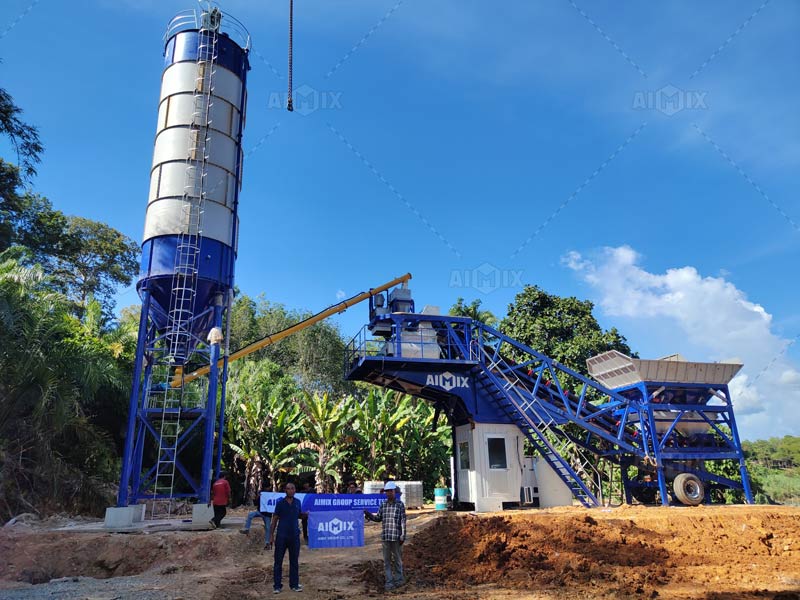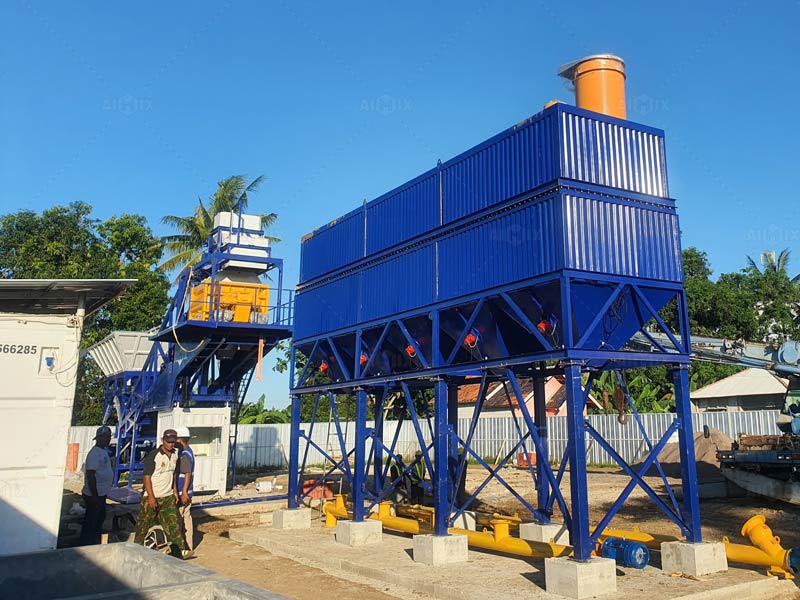When it comes to setting up a concrete plant, mobile concrete plants offer a range of benefits compared to traditional stationary plants. Mobile concrete plants are designed for flexibility, fast deployment, and ease of transport. However, their installation process has specific characteristics that make them different from stationary plants. In this article, we will explore the unique aspects of installing a mobile concrete plant and how they differ from traditional concrete plant installations.
1. Understanding the Mobile Concrete Plant
Before diving into the installation process, it’s important to understand what sets a mobile concrete plant(planta de concreto móvil precio) apart from other types of concrete plants. A mobile concrete plant is a portable batching system that allows concrete to be produced directly at the construction site. This mobility ensures that the plant can be easily relocated to different locations, reducing the need for transportation costs and improving project efficiency.
What Makes a Concrete Plant Mobile?
Unlike traditional concrete plants, which are typically fixed in one location, a mobile concrete plant is designed to be disassembled and transported to different sites. These plants are often mounted on trailers or skids, making them easy to move and set up quickly. A mobile concrete plant usually features modular components, including silos, mixers, and batchers, which can be easily connected or disconnected as needed.

2. Site Preparation for a Mobile Concrete Plant
The installation of a mobile concrete plant starts with site preparation. This is a crucial step in ensuring that the plant operates efficiently and safely throughout its lifespan. Unlike stationary plants, the installation of a mobile concrete plant requires less extensive groundwork, but certain considerations still need to be made.
Assessing the Site
One of the first things to do before setting up a mobile concrete plant is to assess the site. The ground should be level and stable enough to support the equipment, especially for large plants that can produce high volumes of concrete. The location should also provide easy access for transportation trucks, as these will be delivering raw materials such as cement, sand, and aggregates.
Utility Connections
Depending on the plant’s configuration, you may need to connect utilities such as water, electricity, and fuel to the plant(planta de hormigon). Mobile plants often have integrated systems that minimize the need for external connections, but it’s still important to ensure that the required utilities are available and properly connected for optimal operation.

3. Setting Up the Mobile Concrete Plant
Once the site is ready, the installation of the mobile concrete plant can begin. Setting up the plant involves assembling various components and ensuring that everything is working correctly before production starts. This process may take less time than a stationary concrete plant setup due to the modular nature of mobile plants.
Assembly of Key Components
One of the primary differences in the installation of a mobile concrete plant is the quick assembly of its key components. These typically include the aggregate storage bins, cement silo, water tank, mixer, and control system. These components are often pre-assembled or ready to be quickly assembled on-site, reducing installation time.
Each of these components is connected to a central control system, which allows operators to monitor and adjust batching, mixing, and production processes. The mobile concrete plant’s design also allows these components to be quickly disassembled when it’s time to relocate the plant to a new site.
Transportation and Setup Time
Setting up a mobile concrete plant of AIMIX Group is typically faster than setting up a stationary plant, as the equipment is built for easy transport and quick installation. Depending on the size of the plant and the complexity of the installation, the setup time can range from a few hours to a few days. The mobile nature of the plant also means that it can be relocated easily once the project is complete, which is a major benefit for contractors working on multiple sites.
4. Adjusting the Plant for Site-Specific Needs
Although mobile concrete plants are designed to be versatile, each construction site presents unique challenges that may require adjustments to the plant’s configuration. This could include changes to the batching ratios, production capacity, or mixer settings, depending on the needs of the specific project.
Customizing the Plant’s Settings
Before starting concrete production, operators may need to customize the plant’s settings to ensure that the correct mix design is used for the project. This can include adjusting the amount of water, aggregates, and cement used to create the desired concrete mix. Mobile concrete plants often come with advanced control systems that make it easy to customize the settings based on project-specific requirements.
Material Handling Adjustments
Handling raw materials like aggregates and cement may require some modifications depending on the layout of the construction site. For example, if the site has limited space, the storage silos for aggregates may need to be placed in a specific location, or the plant may need to be adjusted to accommodate different types of raw materials.
5. Mobile Concrete Plant Advantages and Considerations
While mobile concrete plants for sale(planta de hormigon en venta) offer many advantages, including flexibility and reduced transportation costs, they also come with certain considerations that must be addressed during installation.
Advantages
- Flexibility: The ability to relocate the plant to different sites gives contractors the flexibility to serve multiple projects without the need to invest in separate concrete plants for each site.
- Cost-Effective: By reducing transportation costs and minimizing the need for permanent infrastructure, a mobile concrete plant can be a more cost-effective option for contractors.
- Quick Setup: Mobile plants are faster to set up and start production, helping projects stay on schedule and reduce downtime.
Considerations
- Space Requirements: Although mobile plants are portable, they still require sufficient space for equipment and raw material storage, so site selection is important.
- Production Capacity: Mobile concrete plants generally have smaller production capacities compared to stationary plants, which may limit their use for very large-scale projects.
- Environmental Conditions: Harsh weather conditions or challenging terrains may require additional modifications or safety precautions during installation and operation.
Conclusion
Installing a mobile concrete plant is a more flexible and quicker process compared to traditional stationary plants. Its modular design and ability to be relocated make it an ideal choice for projects that require mobility and adaptability. While the installation process involves assessing the site, connecting utilities, and assembling the key components, the overall setup time is reduced compared to a fixed concrete plant. However, careful consideration of site conditions and plant adjustments is essential for ensuring optimal performance. Whether you are looking for a mobile concrete plant for sale or exploring the price of a concrete plant, understanding the installation differences will help you make an informed decision and maximize the benefits of mobile concrete production.